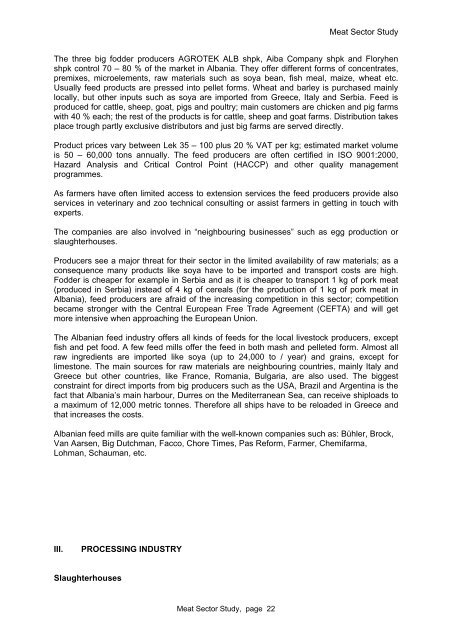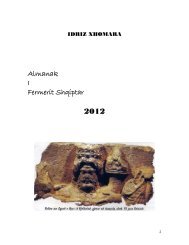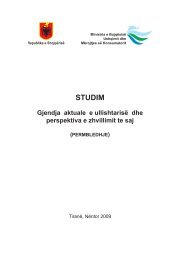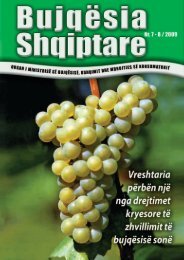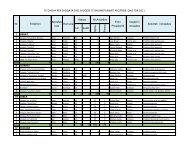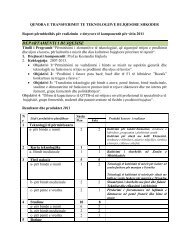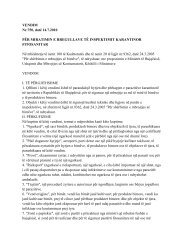MEAT Sector Analyse
MEAT Sector Analyse
MEAT Sector Analyse
- TAGS
- sector
- analyse
- mbumk.gov.al
You also want an ePaper? Increase the reach of your titles
YUMPU automatically turns print PDFs into web optimized ePapers that Google loves.
Meat <strong>Sector</strong> Study<br />
The three big fodder producers AGROTEK ALB shpk, Aiba Company shpk and Floryhen<br />
shpk control 70 – 80 % of the market in Albania. They offer different forms of concentrates,<br />
premixes, microelements, raw materials such as soya bean, fish meal, maize, wheat etc.<br />
Usually feed products are pressed into pellet forms. Wheat and barley is purchased mainly<br />
locally, but other inputs such as soya are imported from Greece, Italy and Serbia. Feed is<br />
produced for cattle, sheep, goat, pigs and poultry; main customers are chicken and pig farms<br />
with 40 % each; the rest of the products is for cattle, sheep and goat farms. Distribution takes<br />
place trough partly exclusive distributors and just big farms are served directly.<br />
Product prices vary between Lek 35 – 100 plus 20 % VAT per kg; estimated market volume<br />
is 50 – 60,000 tons annually. The feed producers are often certified in ISO 9001:2000,<br />
Hazard Analysis and Critical Control Point (HACCP) and other quality management<br />
programmes.<br />
As farmers have often limited access to extension services the feed producers provide also<br />
services in veterinary and zoo technical consulting or assist farmers in getting in touch with<br />
experts.<br />
The companies are also involved in “neighbouring businesses” such as egg production or<br />
slaughterhouses.<br />
Producers see a major threat for their sector in the limited availability of raw materials; as a<br />
consequence many products like soya have to be imported and transport costs are high.<br />
Fodder is cheaper for example in Serbia and as it is cheaper to transport 1 kg of pork meat<br />
(produced in Serbia) instead of 4 kg of cereals (for the production of 1 kg of pork meat in<br />
Albania), feed producers are afraid of the increasing competition in this sector; competition<br />
became stronger with the Central European Free Trade Agreement (CEFTA) and will get<br />
more intensive when approaching the European Union.<br />
The Albanian feed industry offers all kinds of feeds for the local livestock producers, except<br />
fish and pet food. A few feed mills offer the feed in both mash and pelleted form. Almost all<br />
raw ingredients are imported like soya (up to 24,000 to / year) and grains, except for<br />
limestone. The main sources for raw materials are neighbouring countries, mainly Italy and<br />
Greece but other countries, like France, Romania, Bulgaria, are also used. The biggest<br />
constraint for direct imports from big producers such as the USA, Brazil and Argentina is the<br />
fact that Albania’s main harbour, Durres on the Mediterranean Sea, can receive shiploads to<br />
a maximum of 12,000 metric tonnes. Therefore all ships have to be reloaded in Greece and<br />
that increases the costs.<br />
Albanian feed mills are quite familiar with the well-known companies such as: Bühler, Brock,<br />
Van Aarsen, Big Dutchman, Facco, Chore Times, Pas Reform, Farmer, Chemifarma,<br />
Lohman, Schauman, etc.<br />
III. PROCESSING INDUSTRY<br />
Slaughterhouses<br />
Meat <strong>Sector</strong> Study, page 22


